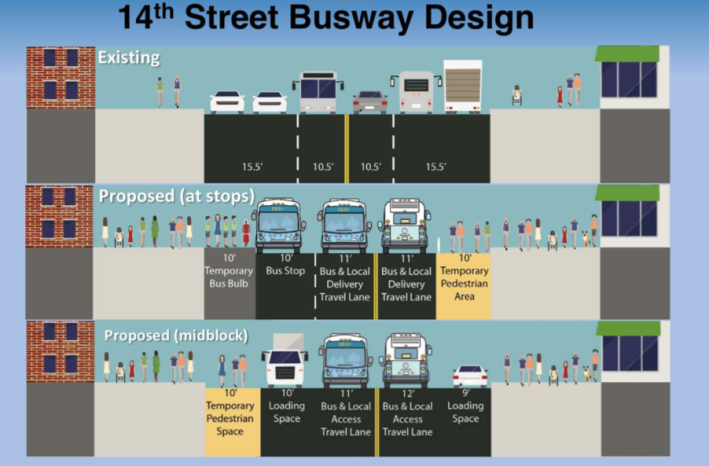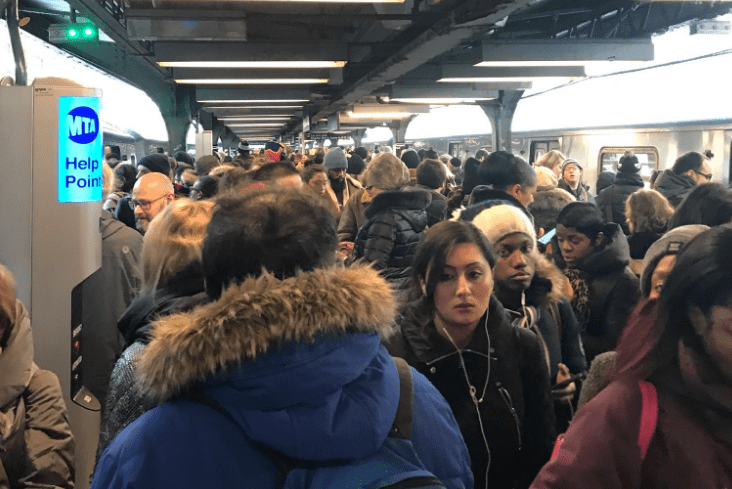UPDATED, Sept. 18
A Manhattan community group says that the current plan for next year's L-train shutdown will fall considerable short of what will be needed to efficiently move the 400,000 daily commuters who will be affected.
In a strongly worded unanimous resolution last week, Community Board 6 told the city Department of Transportation and the state-overseen Metropolitan Transportation Authority that its plan [PDF] needs fairly significant improvements before the L-train shuts down entirely in April.
"Are we concerned? You bet," board member Larry Scheyer told Streetsblog, saying he was not authorized to speak for the full board, but was merely characterizing the general sentiment.
"There was a lot of concern that not enough is being done to keep people moving on 14th Street," he added. Other advocates and elected officials have also made 24/7 bus priority a key demand, arguing that it will be impossible to run 80 buses per hour through the affected area if the busway and other roadways are jammed.

As such, the CB6 Sept. 12 resolution "respectfully" calls on the relevant agencies to:
- Elongate the proposed 14th Street "busway" east from Third Avenue all the way to First Avenue or Avenue C — and extending the "busway" hours to 24 hours a day instead of the current proposal of 5 a.m. to 10 p.m. Because the area east of Third Avenue will not be part of the proposed “busway,” that stretch "will bear the brunt of additional automotive traffic, including for-hire vehicles, thus hampering bus flow," the resolution added.
- Reserve the Williamsburg Bridge for cars with three or more people and buses for 24 hours a day instead of the current proposal of 5 a.m. to 10 p.m. The resolution also urges the DOT to consider converting the Manhattan and Brooklyn bridges to HOV-2-only "during at least peak hours of commuting to stop single-occupant cars and [taxis] from using them to overwhelm the areas affected." Currently, the plan proposes no changes to the other two free East River bridges.
- Limit truck deliveries along 14th Street to the hours between 5 a.m. and 10 p.m. and coordinate with the Police Department "to ensure trucks don’t migrate to smaller side streets during off-limits times."
- Ban taxis and private vehicles from 14th Street entirely, except for emergencies or cars heading to garages. Under the current plan, taxis would be allowed to make pick-ups and drop-offs on 14th Street, even during busway hours.
- Ban new construction within the affected areas until the end of the L train shutdown in July 2020 "to avoid further demands on overburdened streets," the resolution states.
- Get bigger ferries than the 149-passenger vessels that the current plan proposes between South Williamsburg and Stuyvesant Cove eight times per hour. "New York City’s Economic Development Corporation [should] consider using larger, 349-passenger ferries currently used between Rockaway and Wall Street."
- Bar vendors from 14th Street, where sidewalks are expected to be tight.
The resolution passed 36-0.
Streetsblog reached out to DOT, the MTA, the Department of Buildings and the Department of Consumer Affairs and will update this story when we hear back.
After publication of the story, DOT spokeswoman Alana Morales responded to Streetsblog's specific questions:
Question: Will DOT consider converting the Williamsburg Bridge to HOV-3 and bus use 24-7 for the duration of the L shutdown?
Answer: DOT studied traffic volumes over the Williamsburg Bridge and found that creating an HOV-3 restriction from 5 a.m.-10 p. m. (peak travel times) would result in crossing the most people over the bridge without creating congestion on the surrounding streets. DOT, along with NYCT will monitor traffic conditions throughout the 15-month closure and make adjustments as needed.
Question: Has DOT studied converting the Manhattan and Brooklyn Bridges to HOV-2-only during at least peak hours of commuting, to stop single-occupant cars and taxis from using them to overwhelm the areas affected by the L?
Answer: Analysis has shown that diverting trips to other East River crossings would create an increase in traffic volumes on these structures as well as their surrounding street networks. DOT will monitor and make adjustments as needed.
Question: Will the DOT extend the 14th Street “busway” eastward to First Avenue and/or Avenue C to minimize bottlenecks caused by private vehicles and taxis that could severely hamper ferry shuttle buses, etc.?
Answer: DOT traffic analysis evaluated various options for the length of the proposed busway. Busway endpoints at First Avenue or at Avenue C would require all traffic to divert at those intersections, which created more significant traffic shifts than the proposed busway start/endpoint at Third Avenue. Once the reconstruction begins, DOT and NYCT will evaluate traffic conditions and will consider adjustments to the proposed plan as needed.
Question: How about maintaining the 14th Street “busway” on a 24/7 basis for the duration of L train stoppage, since heavy L commuter patterns, especially on weekends, extend far beyond “busway hours”?
Answer: Busway hours support period of highest traffic demand on 14th Street. Based on hourly traffic volumes on the Williamsburg Bridge and along 14th Street summarized, we do not consider the busway restrictions to be necessary for a full 24-hour day but will monitor and make adjustments as needed.
Question: What about banning taxis and private vehicles on 14th Street 24/7 during the L shutdown because you know they're going to be stopping and blocking buses.
Answer: Taxis will be subject to the same rules as any passenger vehicle with respect to access to 14th Street. Taxis making a pick-up or drop-off along 14th Street would have to make the next right-hand turn off of 14th Street. This will be enforced via cameras and NYPD presence.






